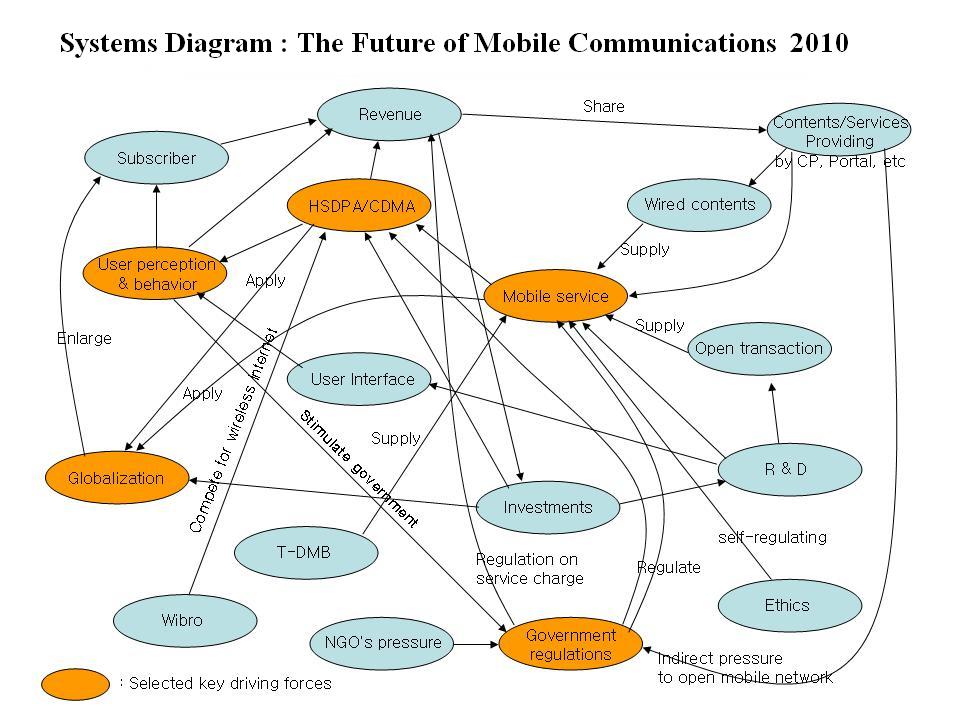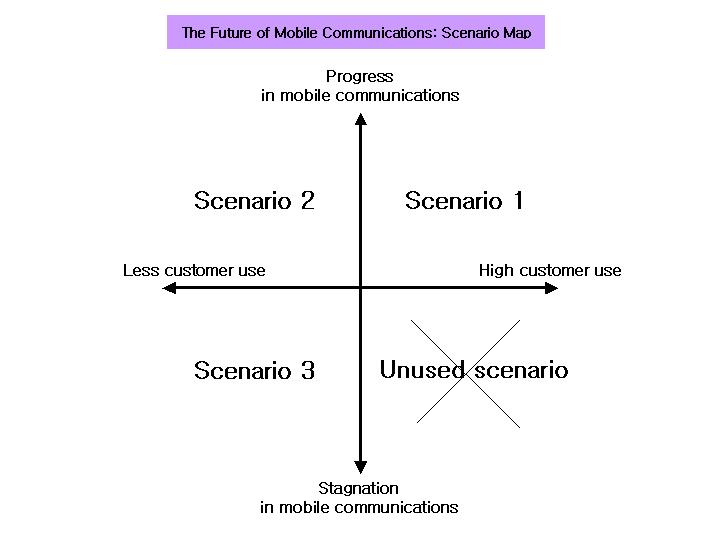The Future of Mobile Telecommunications in Korea 2010
Group Composition
Our members are as below..
- Pyo, Kwang Joon
- Choi, Hack Soo
- Kim, Yang Mi
- Yang, Yoon Seon
Introduction
SK Telecom(SKT) and KT Freetel(KTF) provide voice, data and various value-added services as the 1st and the 2nd wireless operator in Korea. Korean wireless telecommunications market is facing new challenges including saturated subscriber and voice revenue, WCDMA and Wibro(Wireless Broadband Internet) service started on July this year, increasing DMB demands, etc. At this time, we will research and find drive forces of wireless telecommunications and develop the plausible scenarios in the future. Our team has 4 members working for SKT, KTF and Korea Institute of Design Promotion. We expect that we can share various view points.
Research Questions
1. What does mean recent increase of online open market to operator?
2. What is the future effects of the pressure of decreasing service price?
3. How portals will make their revenue from wireless Internet?
4. Will T-DMB become a major service?
5. How to make a new growth engine in the mobile internet business?
6. How will mobile operators make a blue ocean in the saturated mobile market at present?
7. What is maximum number of mobile subscribers in Korea?
8. How can make profits from DMB service for mobile operators?
9. Can mobile operators create and have initiative on the mobile advertising market?
10. Why mobile companies concern about the mobile VoIP service?
11. Will Wibro sevice become a dominant service? Wibro vs. HSDPA
12. Is it possible to change from a mobile company to an entertainment company?
13. Will the revenue of wireless Internet increase consistently?
14. How fast will the HSDPA service replace the CDMA?
15. Will SK Telecom succeed in global business?
16. as a third player, LG Telecom's future will be?
17. Which service is more valuable for customers between HSDPA and Wibro?
18. What is the ethic problem in delivering Telecommunication Service?
19. How to make successful mobile internet business?
20. Can the mobile user interface be enhanced in the future?
Driving forces
DE: Good start on the driving forces, but please use the template and the instructions in the DF section, it ensures consistency of all of the 200+ driving forces.
1. Open transaction in contents distribution
2. Promissing contents development in wired Internet
3. T-DMB service penetration rate
9. User perception and behavior
10. Mobile contents and services
Systems Diagram
Scenario map
Scenarios
Some key drivers had been selected for Korea’s future mobile telecommunication in the systems diagram, and these drivers were regrouped and allocated on an axis of coordinates, X axis for progress or stagnation in mobile communications and Y for customers use. By using this method, three scenarios have been made for the “Future of Mobile Telecommunications in Korea by 2010”
- Scenario 1. The most best case for mobile companies.
First, the new network, called HSDPA, had been successfully settled covering all the areas of Korea with customer’s satisfaction. And mobile companies considered to develop the next generation mobile network.
Second, mobile operators made good results in global business. Several successful M&As were made in Asia, Europe and America, and also they invested effectively on the new markets like Mongol, Vietnam making a lot of subscribers. Some Korean companies sold platform based solutions like LBS, Telematics, m-commerce and m-search etc. to China and USA. There are also active global partnerships between wired portal companies and mobile companies.
Third, as the technologies developed so fast, mobile based solutions like LBS, commerce, personalization etc. became core solutions. Based on these solutions and network technologies, there were a lot of new data services which making more values and satisfaction for people. And luckily, the mobile VoIP was not on service as mobile companies still controlled their wireless network power against mobile VoIP companies.
Fourth, customers recognized how the mobile services, not only voice but also data services, were useful for their life and gradually became popular services making company’s new profits. The mobile internet business was being activated and data profits went up from 20% to 50% of total revenue. Moreover stock annalists said more values were expected on the mobile internet business.
Lastly, the government regulations on mobile companies were being mitigated as the MIC(Ministry of Information & Communication) had a nightmare with LG Telecom which gave up a license for the WCDMA business causing some problems or responsibilities. LGT gave up not only WCDMA but also all mobile business as they couldn’t afford to invest for the new network any more. KTF merged the LGT, and therefore there were only 2 major mobile companies remained in Korea.
As the above results, End of 2010, telecommunication companies in Korea were still going on very well.
- Scenario2. They were in the Chasm.
First, mobile companies launched the HSDPA service with 84 cities covering 95% of country and they were seriously considering for the new investment on the next wireless network, because they did not make money from the HSDPA service. It was worse than they thought at the beginning of the service.
Second, the global business, aggressively driven by mobile companies, did not make success. It may be said that some parts, like voice business of backward countries, made profits, but the data services in USA and China were still in difficult situation.
Third, lots of new services were developed and offered to customers, but these services were not activated as customer did not feel that these were useful for them. There was still a high barrier between mobile company’s hope and customers use. Companies realized that they were locked in the “Chasm” and tried to break to through them. However the voice profit was still remaining, so companies were just managing with proper cash flow.
As the above results, End of 2010, mobile companies were seriously considering how to break through all the barriers to survive.
- Scenario3. This is the worst case.
First, mobile companies launched the HSDPA service in 84 cities and it seemed successful at the beginning, but they couldn’t make enough subscribers for the returning on investment. They have no idea that how to prepare for the next wireless network.
Second, the global business, mobile companies had driven, was not clear, it may be better to say that it was totally failed. This is because, a lot of money needed to invest and they couldn’t afford to do that against the giant global mobile companies like Vodafone, T-Mobile and NTT DoCoMo.
Third, many services, especially data services, were offered to customers, but these were not activated as customer felt that these were not valuable. They found there was still a high barrier between mobile company’s thinking and what customers really want. The S-DMB service failed when T-DMB became more popular. But the T-DMB service also did not make money as it was free. SK Telecom was considering that how to quit the S-DMB service. Manufacturer tried to enter on mobile internet business like Samsung and CJ. It makes sense that they could control mobile devices and content. So, mobile companies became just network providers.
Fourth, mobile companies were still finding for the new growth engines. The NGOs pushed government and mobile companies to cut voice traffic fees. The government pushed mobile companies to do this, as there ware several important elections including presidential election. Some ethic problems also emerged making serious social issues. These resulted 40% cut of company’s profits.
Lastly, government suddenly decided to open the mobile company’s walled garden without any conditions to activate wired & wireless internet market. In the market, the wired internet portals had advantages as they had already been many years in internet business. Also some independent sites made their own business successfully in the adult service area like sex, photos, meetings, chatting etc. Therefore mobile companies lost their initiatives and market in wireless business.
End of 2010, mobile company’s profit was getting worse and wired internet portals tried to merge a mobile company. This would be a nightmare for the mobile companies.

